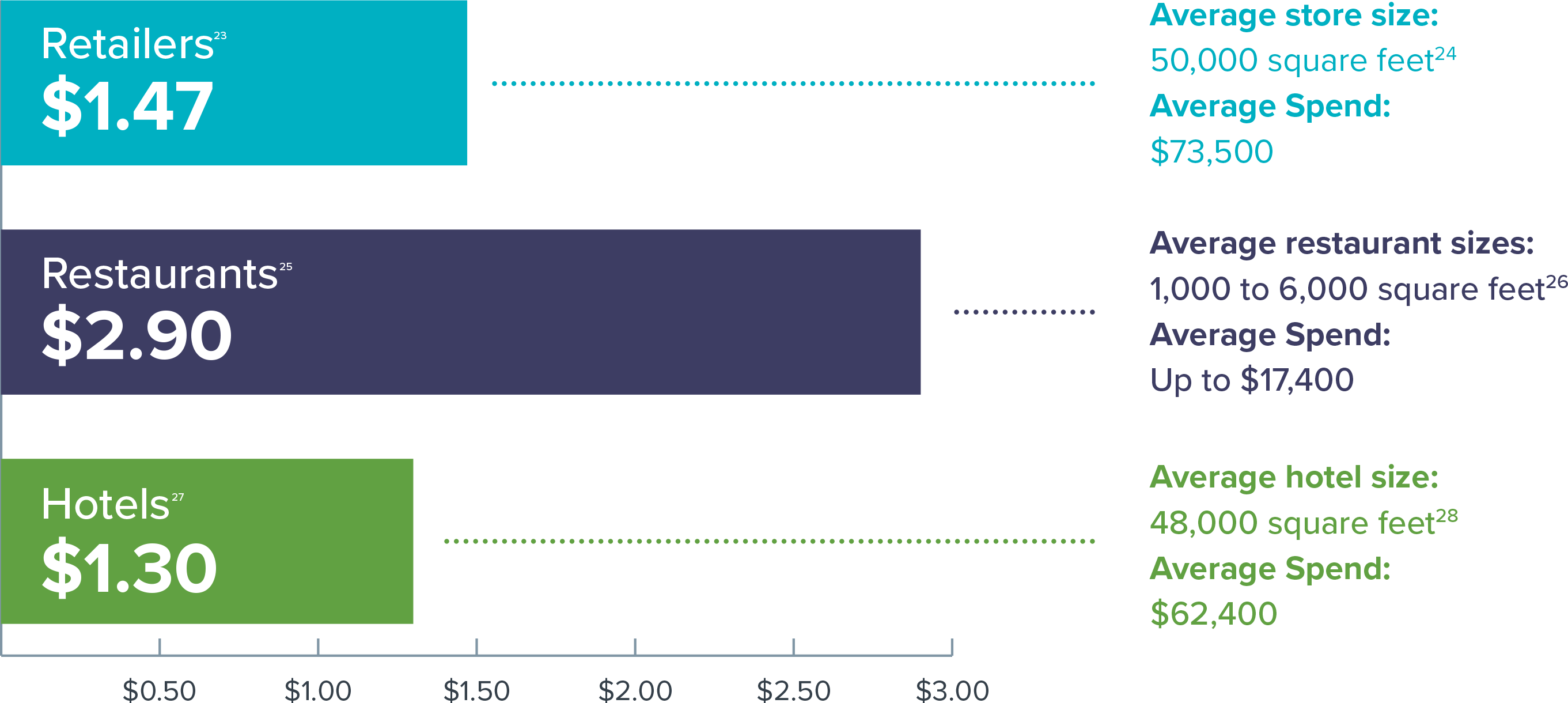Your Customers
Today’s consumers -- especially younger generations -- are committed to sustainable solutions. Not only does an energy management program save money, but it also creates a healthier and safer business and planet.
Industry stats on the impact COVID-19 has had on other businesses like yours
Examples of how innovative brands have responded and adapted their businesses
How businesses like yours can evolve and thrive in the current economy
Which areas businesses can reduce expenses without negative consequence
How much businesses like your stand to save by reducing energy costs
From customers to employees to media, who cares about your energy choices?
How much money retailers, restaurants and hotels stand to save by switching to energy efficient lighting
An emerging service model that lets business owners upgrade their lighting and save on utilities without any upfront expense
Roughly 164K businesses have closed as a result of the pandemic, according to the recent Yelp Local Economic Report. Restaurants and retailers have been hit especially hard.
The impact is expected to continue well into 2021.
One analyst even developed a stress test score, to predict which retailers might not survive. These 24 restaurant chains will likely be shutting locations.
As retailers, restaurants and hotels plan for the next phase of COVID-19 recovery, they look to solutions that continue to support customer health, bring in new sources of sales and contain operational costs.
The recovery will be a slow one, but smart businesses are discovering an untapped source of savings -- one that can also make the customer and employee experience better -- energy.
Here is your roadmap to recovery, with a focus on a relatively simple way to delight your guests and save you thousands of dollars.
This eBook provides insight into the impact COVID-19 had on restaurant, retail and hotel businesses in 2020 and covers creative steps you can take to reduce expenses.
You’ll discover:
Online shopping and food delivery have had an impact on brick-and-mortar industries over the past five years. And brands -- retail, restaurant, and hospitality -- have been steadily integrating technology and omnichannel experiences into their thinking.
Then a pandemic reared its ugly head, accelerating and morphing that transformation. Many multi-location chains shut down stores. Some brands went out of business entirely. Travel risks and limitations, as well as the cancellation of live conferences and meetings, have taken their toll on hotels, motels, and resorts.
Retailers were already facing challenges prior to the pandemic, competing with Amazon and dealing with the slow demise of many shopping centers. Reduced traffic and social distancing guidelines cut into their profit margins even further.
You're not alone in your challenges.

Not only is business down, but those who are still open are working with fewer operational hours and employees and dealing with increased expenses.
.png?width=1400&name=Page5-2%20(1).png)
Consumers abandoned meals in restaurants and overall sales plummeted 34 percent.8 That had a direct impact on employment as well, with staffing levels at 71 percent. Revenue per available hotel room is down a massive 48 percent.
Like other types of businesses, hotels needed to invest in safety precautions, driving up their expenses.
All of these industries faced significant downturns and rising costs.
Large and small brands alike took major steps to reduce expenses and find creative new ways to appeal to customers as foot traffic plummeted.
Some companies have actually seen an uptick in sales during the COVID-19 pandemic and others are finding new and unique ways to cut costs without sacrificing the customer experience.

Wayfair, Overstock, and At Home fared well in the retail category, proving that even a tactile category like home furnishings can thrive when consumers need timely solutions.
The work-from-home trend clearly fueled these retailers’ success.




Those retailers -- large and small -- who were able to quickly pivot to online models fared well. Expanding their lines to include products like masks, bedroom slippers and other necessities during lockdowns delivered a boost to creative businesses who focused on consumer needs and behavior shifts.

Extended stay hotels performed well and some hotel brands found new ways to market their rooms -- focusing on staycations. Others donated rooms to first responders. Although that may not have solved their financial woes, these brands built awareness as companies that give back to those in need.
These successes show us that some old principles of business and marketing have never been more true.



Retailers are looking at their product offerings and how to use every square foot of indoor and exterior space to promote their brands. KPMG declares that there is “no going back” for retailers, as they will need to accelerate their move to omnichannel delivery, a trend that began prepandemic.
The restaurant industry may not recover until 2023 and will likely undergo significant changes in how restaurants serve customers.
There are some ways businesses can survive in the meantime.




Make sure you have the right talent to create new solutions and deliver a superior customer experience. Invest in your culture to attract and retain those people.
Hiring during COVID-19 may rely heavily on virtual interviewing. Make sure you’re prepared for this.



Cut into fat rather than muscle, seeking meaningful ways to reduce expenses while delivering best-in-class experiences to customers and employees.
Do not sacrifice the customer experience or scrimp on those benefits that help you retain the best talent.
Where will those funds come from? Cost management is vital -- not only for cash flow but also for freeing up investment dollars for new ideas and marketing.
Now is a great time to re-examine your monthly and annual expenses and map-out a cost reduction plan for 2021 and beyond.
As you go through each line item, ask yourself, “How will this affect service delivery and customer satisfaction?”

The food you serve or products you sell are critical to your business. While it might be tempting to buy cheaper ingredients or pull back on your offerings, it's important to deliver a quality experience for your customers. Cutting back here might cost you.

The people who help you deliver guest
satisfaction and results are essential to retailers, restaurants, and hotels. If you must reduce your staff, make sure that you still have the right people in place to serve your customers.

It's a great idea to regularly audit the technology you subscribe to. This helps ensure that you're only paying for tools that add value to your business.
A word of caution here though. Expedited delivery, touchless solutions and online-only service options are good reasons to consider investing more in this area, not less.

This is typically where you'll find the biggest potential for savings. Whether it's going paperless or evaluating your workspace - chances are you can save thousands of dollars by taking a closer look at your operations.
There is a source of major savings here that is often overlooked -- energy expenses.
Restaurants consume 3x more energy per square foot than other commercial buildings.
While the cost per square foot is substantially lower for hotels and retailers, the size of these buildings causes energy costs to add up - running well over $60,000 each year.
Full service hotels spend 4-6% of revenue on energy. This can be up to 10% for historic and luxury properties.
Energy Star reports that retailers spend $20 billion on energy each year.

Energy costs include HVAC, electricity needed to operate equipment and technology, water consumption, food preparation and lighting.
Here's a closer look at how these expenses break down.

Do the math. If you can find creative ways to reduce energy expenses, you’ll free up thousands of dollars that can be redeployed to other business-building programs.
Start with a thorough energy audit. This energy audit checklist guides you through a step-by-step review of your company's energy usage. It will help you find areas where you're wasting money, and create a plan to correct the issues.
If you run multiple locations, conduct an audit for each and compare them to one another.
In an ideal world, you could simply flip a switch and begin to enjoy energy savings. People are ultimately the engine behind making significant changes to your operations. But even in small organizations, capital improvements take time and persuasion.
There are five groups of people who are vital to an energy- and cost-saving initiative.
Today’s consumers -- especially younger generations -- are committed to sustainable solutions. Not only does an energy management program save money, but it also creates a healthier and safer business and planet.
Once your team fully understands the impact that saving energy can have on both business and personal health, they’ll become advocates and ambassadors.
Cleaner air, better lighting (which improves productivity), and safety in common areas are just a few of the many personal benefits your valued employees will enjoy.
By selecting and installing the right lighting systems, restaurants, retailers, hotels and other brick-and-mortar operations have seen more than $200 million in energy-savings.
LED lights use 90% less electricity than incandescent light bulbs and 50% less than fluorescent lighting.
LED lights not only use less energy to operate, but these systems include dimmers, sensors and smart placement of lights to ensure you have just the right amount of lighting at the right times of the day and seasons.
Retailers, restaurants and hotels stand to save substantial by switching to LED lights. Not only do LEDs use less energy, but they last longer than traditional bulbs, decreasing maintenance costs.
$3,380 maintenance savings per year
$12,484 energy savings per year
$15,864 total savings per year
$237,955 total savings by partnering with FES
We’re all used to subscription models in our lives as consumers and in business. For example, Software-as-a-Service (SaaS) is a way that companies can access sophisticated or expensive technologies, paying for usage rights on a monthly basis.
Lighting-as-a-Service (LaaS) is a relatively new concept. It allows “subscribers” to pay for energy efficient lighting systems over time, long after they've cashed in on the savings.
FES covers the entire upfront cost to design and install the new lighting system, plus includes ongoing maintenance within the monthly fee.
Subscription models have numerous advantages.



FES makes it easy for businesses to make smart energy choices that deliver exponential value.
We've partnered with thousands of small businesses across the country to:
Generate
in energy savings
Install
energy efficient lights
Eliminate
of CO2 emissions/yr
Future Energy Solutions is on a mission to make it easy for businesses to make smart energy choices.
We design, deliver, install, and maintain LED lighting upgrades with zero capital cost up-front, making it easier and more cost effective than ever for businesses to switch to LED. We work closely with our customers to engineer custom lighting solutions perfectly tailored to individual business needs that deliver unrivaled savings.
For more practical tips on energy savings, post-pandemic recovery, and SMB operations, subscribe to our blog - the FES View.